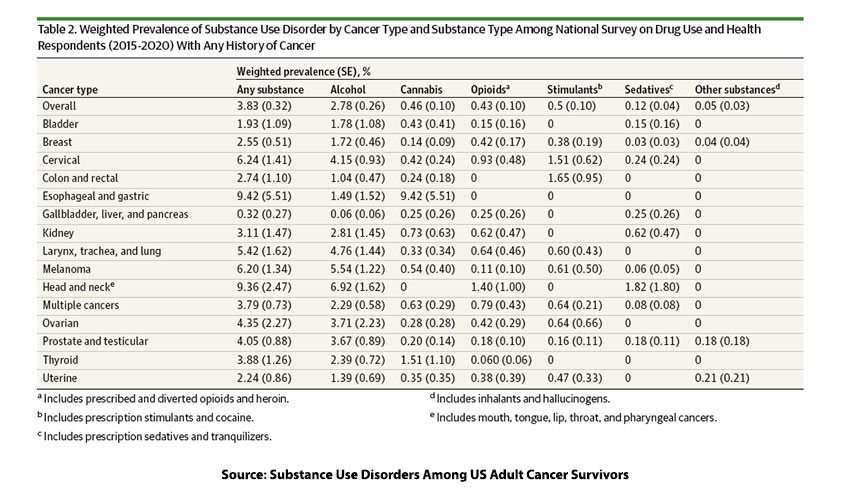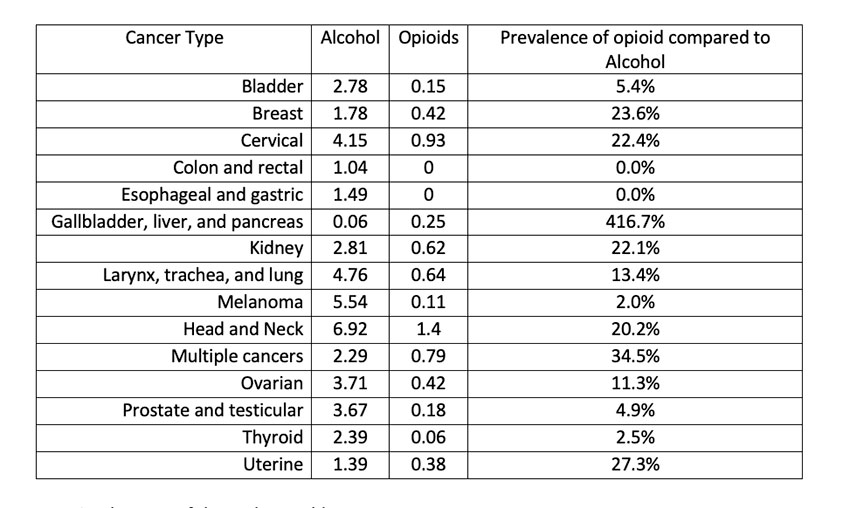Before jumping in, here's a quick reminder: Prevalence is the number of individuals with a condition in some defined population, e.g., 2 out of 100, and is often expressed as a percentage, 2%. The dataset comes from the National Survey of Drug Use and Health, which began asking about an individual’s history of cancer in 2015. All individuals 18 or older who self-reported a solid organ cancer (not blood-borne like leukemia) were included, and the diagnosis of substance use disorder (SUD) was based on self-reported behavior during the previous year. The researcher identified 6101 adult cancer survivors.
61% were female, and 57% were aged 65 years or older. Because cancers vary with age and gender, the results were weighted to account for different numbers of each type of solid organ tumor. Across all cancer survivors, the prevalence of active SUD was 3.83% or nearly 4 out of 100 individuals. The prevalence of SUD, as well as the substance of misuse, varied with the type of tumor. Before looking at the table, I should mention an important caveat. The data does not indicate whether a SUD existed before the onset of cancer, so we cannot assume that the SUDs were a result of a cancer diagnosis. The one exception might be head and neck malignancies where alcohol use is a known and common risk factor – this may explain, in part, the “markedly higher” prevalence of alcohol use disorders in this subgroup.

With three notable exceptions, alcohol was the substance of choice over cannabis, opioids, stimulants, sedatives, and other substances (including inhalants and hallucinogens)
The three exceptions included gallbladder, liver, and pancreas tumors, where alcohol would clearly cause further damage and perhaps accelerate the cancer. Those patients chose cannabis, opioids, and sedatives. The second exception was gastric and esophageal tumors; the overwhelming choice of substance was cannabis because it is more than likely to combat the eating problems associated with those two tumors. The third exception was colon and rectal tumors, where stimulants were the first choice. I have no idea why.
In the push to create an opioid-free world, patients with cancer experiencing pain are often “protected” from abuse by being denied these medications. Here is what the study says about opioids: the substance capturing all the headlines, the clear and present danger when prescribed.
“Opioid use disorder and prescription sedative use disorder were generally uncommon (<1%) among survivors of all types of cancers….”
Below, I have calculated the difference in prevalence of opioid use disorder compared to that of alcohol. The results are eye-opening.
 Here is what one of the authors told Stat:
Here is what one of the authors told Stat:
“There are a few consequences you might be concerned about. One might be about prescribing opioids for pain, which can be indicated even with substance use disorder. Undertreated pain has all sorts of consequences, including someone’s ability to tolerate life-saving or prolonging cancer treatment.”
- Devon Check, PhD Duke Cancer Institute
This may be an excellent study for the physicians at PROP to read and consider. It seems, at least according to this study, except for people who have cancer of the gallbladder, liver, or pancreas, that alcohol is a far more significant problem than opioids. Of course, focusing on alcohol would leave the leadership of PROP without expert witness fees and chances to appear before Congress to push their “special interests.”
Source: Substance Use Disorders Among US Adult Cancer Survivors JAMA Oncology DOI:10.1001/jamaoncol.2023.5785




